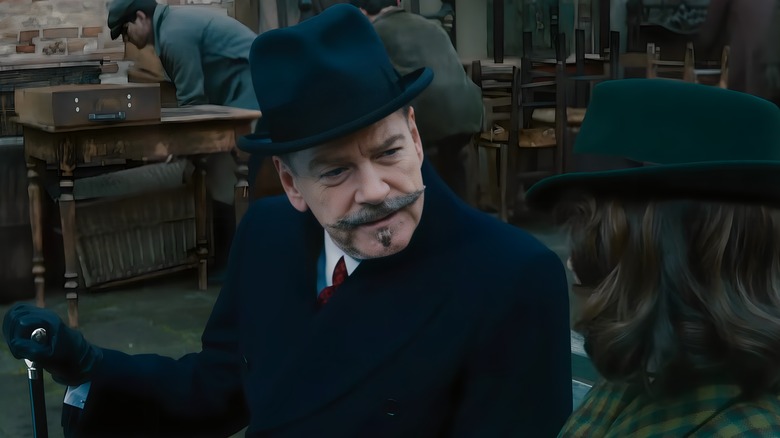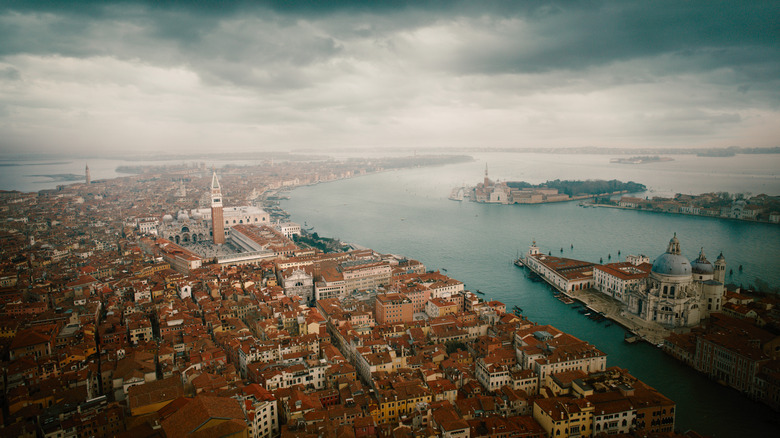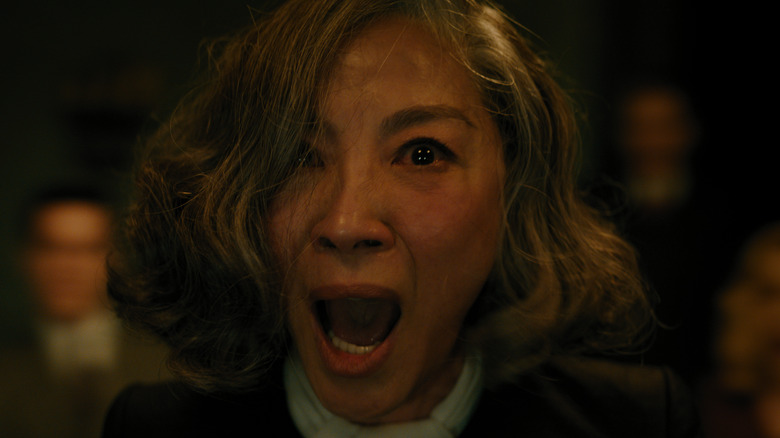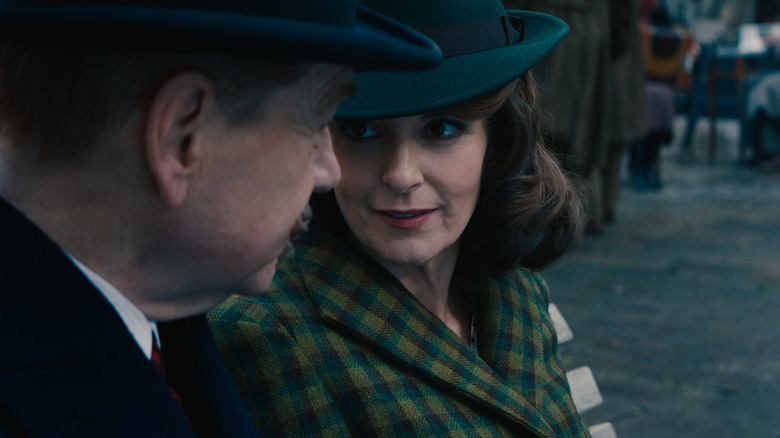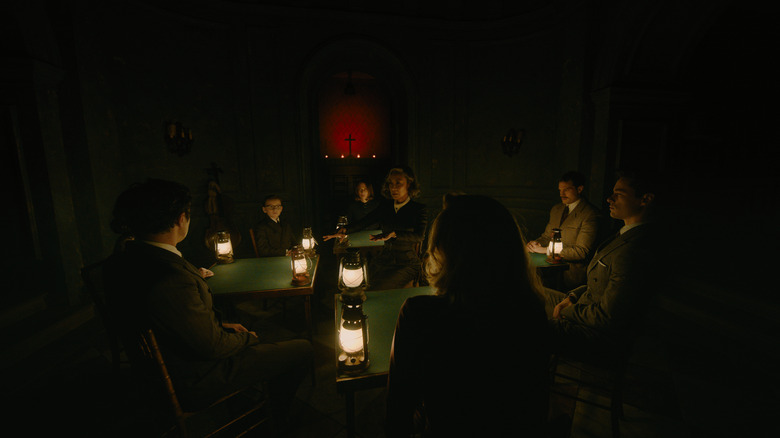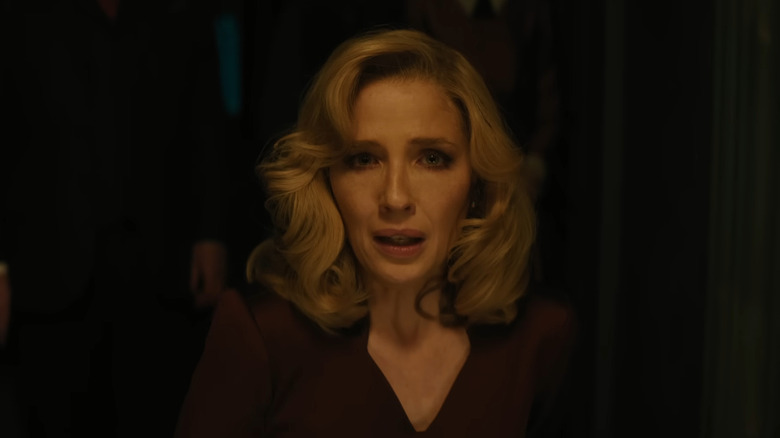A Haunting In Venice: 5 Ways Kenneth Branagh Changed Agatha Christie's Story
Contains major spoilers for A Haunting in Venice
Kenneth Branagh's "A Haunting in Venice" is finally here, marking the third installment of his middlingly received series of Agatha Christie adaptations, which he produces, directs, and stars in as the detective Hercule Poirot. Critics seem to shrug with each new release — "Venice" currently boasts a series high 60/100 on Metacritic – and audience interest declined dramatically between the first two films. Case in point – the real "Death on the Nile" was its $46 million domestic haul, though, charitably, the box office still hasn't recovered from the COVID-19 pandemic. But it's hard not to see these adaptations as herculean labors of love from the "Oppenheimer" actor.
And yet, while Branagh dons many different hats (and, presumably, mustaches) for each opulent murder mystery, it's arguably screenwriter Michael Green who finds himself confronted with an equally difficult — and thankless — job of finding ways to surprise modern audiences with source material from nearly a hundred years in the past. Though some may enjoy the melodrama of Christie's novels, the real draw is, of course, the carefully crafted mystery at the center. As such, Green must balance honoring what the English author originally penned in the 20th century with fresh twists and turns that will keep audiences intrigued in 2023. "A Haunting in Venice" is potentially Green's biggest departure from Christie's writing, hopefully turning the 1969 novel "Hallowe'en Party" into the box office bounce-back Branagh's series needs.
A Haunting in ... England?
The first major change Kenneth Branagh and Michael Green made to "Hallowe'en Party" was its title and setting. Shocking as it may be, the entirety of the action in "A Haunting in Venice" takes place ... in Venice, following in the footsteps of "The Equalizer 3" and "The Nun II" to round out a bizarre late-summer trilogy of violent films set in Italy. The formerly titular gathering is held at a Venetian palazzo, said to be haunted by the ghosts of dead children eager to unleash their spectral rage on any doctor who dares set foot in their haunt.
Agatha Christie's book was set in her home country of England, specifically the fictional village of Woodleigh Common. It's possible it was based on the real village of Woodleigh, which is located in Devon County. In the late 19th century, there were just 213 people living within its 2,319-acre limits, which squares with the quiet, residential village depicted in "Hallowe'en Party."
Not everyone was invited to this Hallowe'en Party
Like the previous two Kenneth Branagh-Agatha Christie films, "A Haunting in Venice" boasts a star-studded cast playing an ensemble of larger-than-life murder suspects. As large as the movie cast is, however, the book's cast was even larger. Among the missing group are Judith Butler (Ariadne Oliver's close friend who invites her to the party), her daughter Miranda, and the arrestingly gorgeous gardener Michael Garfield.
Additionally, a number of existing characters were altered in various ways from their "Hallowe'en Party" counterparts. Most notably, Michelle Yeoh's scheming mystic Joyce Reynolds was a 13-year-old girl. She also had an older sister named Ann and a younger brother named Leopold, the latter of whom appears in the film (played by Jude Hill, who previously starred in Branagh's Oscar-winning film "Belfast"). Instead of being Joyce's sibling, however, he is written to be Dr. Leslie Ferrier's (Jamie Dornan) son. Desmond Holland, a teenager from the novel, is reimagined for the film as two half-siblings — Desdemona (Emma Laird) and Nicholas (Ali Khan) — working for Reynolds.
Finally, two characters appear wholly original to Branagh's film — Maxime Gerard (an antagonistic wannabe aristocrat secretly heartbroken over the death of his ex-fiancee, played by Kyle Allen) and Vitale Portfoglio (Hercule Poirot's personal bodyguard, played by "John Wick: Chapter 2" star Riccardo Scamarcio).
Ariadne Oliver is given a major rewrite
As a mystery novelist herself, perhaps it's fitting that Ariadne Oliver delivers the most shocking twist "A Haunting in Venice” has to offer. Though she blows into the film with jarring energy (and an equally jarring accent from Tina Fey) as Hercule Poirot's close friend and quasi-chronicler, it's ultimately revealed that she lured him to the Hallowe'en seance — in collaboration with Portfoglio and Reynolds — to create a best-selling story. In the context of "A Haunting in Venice," it's a staggering betrayal that shakes Poirot. But for anyone familiar with the Agatha Christie canon, it's a huge subversion of expectations.
Ariadne Oliver wasn't just a benevolent supporting character in "Hallowe'en Party" — she was originally written by Christie as a fictionalized version of the author herself. Over the course of her career, Christie became increasingly critical of her early work on the Poirot series, particularly taking issue with the central character's egotistical personality. Though she continued to write for the character due to his popularity, she would infrequently use Oliver to push back against the domineering Belgian detective, as well as to poke fun at perceived mistakes in her first books.
While it's surprising that Kenneth Branagh and Michael Green would portray Oliver so deviously, it seems Christie saw this potential for the character as well. In her notebooks, Christie had begun plotting a book in which Oliver would organize a murder mystery and/or treasure hunt, turning from friend to suspect after a body is discovered.
Agatha Christie's party had a higher body count
Both "A Haunting in Venice" and "Hallowe'en Party" tell stories about recent murders connected to unsolved deaths from years past. In the film, the mystery's central tragedy is the death of Rowena Drake's ("Yellowstone" star Kelly Reilly) daughter Alicia. After Joyce Reynolds falsely claims during the seance that Alicia was murdered and that she will identify the culprit the following night, the "psychic medium" is found impaled on the arm of a large statue. Over the course of Hercule Poirot's investigation, Dr. Leslie Ferrier is also killed via coerced suicide, thus maintaining the ruse that ghostly children are slaying the doctors present.
There are several victims from the past in "Hallowe'en Party," most notably Ferrier and Olga Seminoff (Camille Cottin) — in contrast, Seminoff survives the entirety of "A Haunting in Venice." The first victim to be killed within the book's timeline is 13-year-old Joyce Reynolds, who also falsely claims to have information about a murder, hoping to catch the attention of famous author Ariadne Oliver. She is drowned in an apple-bobbing tub, just like Poirot almost is in the film. The final victim is her brother, Leopold, who is also drowned by the killer — Rowena Drake.
Same killer, different motive
We did give you a spoiler warning — the killer in both "Hallowe'en Party' and "A Haunting in Venice" is none other than Rowena Drake, the grieving widow and host.
However, in the book, Drake doesn't act alone. While still married to Mr. Drake (who died sometime prior to the novel's events under unexplained circumstances), Rowena has an affair with the gardener Michael Garfield. Once their tryst is discovered by Drake's aging aunt, she is quietly disinherited. Together, Drake and Garfield hire Leslie Ferrier to forge a will restoring Drake's fortune, then murder both Ferrier and the would-be heir — Olga Seminoff — to cover up their crime.
Young Miranda Butler sees the disposal of Seminoff's body but has this revelation usurped by an attention-seeking Joyce (who pays dearly for her deception). Leopold witnesses Joyce's murder and attempts to blackmail Drake, sealing his own fate as well. Hercule Poirot speculates that, after the fortune was secured, Garfield would have murdered Drake to steal the money for himself, with which he planned to construct an unparalleled garden.
In the film, Rowena Drake murders Joyce Reynolds and Ferrier to conceal her role in the death of her daughter, who was accidentally killed by hallucinogenic poison secretly fed to her by her own mother. There is also a blackmail subplot in the film, though Drake assumes the blackmailer to be Joyce — not Leopold, the real blackmailer whose ill-gotten funds were meant to aid his ailing father.
